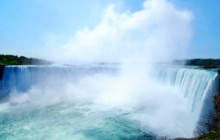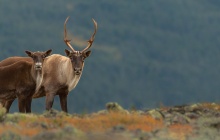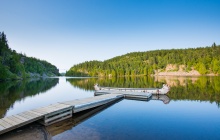Discovery of Quebec's wildness and rich cultural heritage
TORONTO > NIAGARA > HUNTSVILLE > OPEMICAN > ROUYN NORANDA > AIGUEBELLE > AMOS > VAL D'OR > MONT-TREMBLANT > MONTRÉAL
Itinerary
-
Day 1 Toronto
 Welcome to Toronto! Depending on your flight arrival time, take time to discover the "Queen City". The capital of Ontario, Toronto is one of Canada's largest cities. This cosmopolitan city with its relaxed atmosphere is sure to win you over. Take advantage of your evening to go for a nice walk in the heart of the city.
Welcome to Toronto! Depending on your flight arrival time, take time to discover the "Queen City". The capital of Ontario, Toronto is one of Canada's largest cities. This cosmopolitan city with its relaxed atmosphere is sure to win you over. Take advantage of your evening to go for a nice walk in the heart of the city.
- Accomodation : hotel
-
Day 2 Toronto
 The city itself is a must-see. From art-filled streets like Graffiti Alley to the immense CN Tower, it is clearly impossible to get bored in Toronto. Visit the lively Distillery District or the majestic Casa Loma Castle. Looking for baseball, basketball or field hockey game? Join a team of fans to watch a game.
The city itself is a must-see. From art-filled streets like Graffiti Alley to the immense CN Tower, it is clearly impossible to get bored in Toronto. Visit the lively Distillery District or the majestic Casa Loma Castle. Looking for baseball, basketball or field hockey game? Join a team of fans to watch a game.
- Accomodation : hotel
-
Day 3 Toronto / Niagara Falls / Toronto
 In the morning, pick up your rental car and head for Niagara Falls! Youhave been dreaming about them - here they are, the famous Niagara Falls! Take a cruise to get up close, and feel the full force and power of the falls. A spectacular experience guaranteed!
In the morning, pick up your rental car and head for Niagara Falls! Youhave been dreaming about them - here they are, the famous Niagara Falls! Take a cruise to get up close, and feel the full force and power of the falls. A spectacular experience guaranteed!
- Included activity : cruise on Niagara falls
- Accomodation : Hotel
- Transportation : 162 mi approx., 3h -
Day 4 Toronto / Hunstville
 Head to Huntsville, located near Arrowhead Provincial Park and Algonquin Provincial Park. Also named as the "Adventure Capital of Ontario", this town is ideal for hiking, biking, tasting the local gastronomy, or try various cultural activities such as visiting art exhibits or shows. This city is sure to satisfy your thirst for adventure and discovery!
Head to Huntsville, located near Arrowhead Provincial Park and Algonquin Provincial Park. Also named as the "Adventure Capital of Ontario", this town is ideal for hiking, biking, tasting the local gastronomy, or try various cultural activities such as visiting art exhibits or shows. This city is sure to satisfy your thirst for adventure and discovery!
- Accomodation : hotel
- Transportation : env. 143 mi approx, 2h30 approx. -
Day 5 Hunstville
 Take advantage of this day to discover Algonquin Provincial Park. Located in the middle of the province, between the Ottawa River and Georgian Bay, it is Ontario's largest park, with 7,600 km2 of natural space. A jewel of wilderness purity, it is the ideal place for nature lovers.
Take advantage of this day to discover Algonquin Provincial Park. Located in the middle of the province, between the Ottawa River and Georgian Bay, it is Ontario's largest park, with 7,600 km2 of natural space. A jewel of wilderness purity, it is the ideal place for nature lovers.
- Accomodation : hotel
-
Day 6 Huntsville / Opemican national park
 Hit the road for the Abitibi-Témiscamingue region. Explore the magnificent Opemican national park, bordered on either side by Temiscamingue Lake and Kipawa Lake. Ideal for nature lovers and water sports enthusiasts!
Hit the road for the Abitibi-Témiscamingue region. Explore the magnificent Opemican national park, bordered on either side by Temiscamingue Lake and Kipawa Lake. Ideal for nature lovers and water sports enthusiasts!
- Accomodation : ready-to-camp
- Transportation : 137 mi approx., 2h30 approx. -
Day 7 Opemican national park
 As a family, a couple or with friends, everyone can enjoy this grandiose park.
As a family, a couple or with friends, everyone can enjoy this grandiose park.
Suggested activity ($):
- canoe trip-Accomodation : ready-to-camp
-
Day 8 Opemican national park / Aiguebelle national park
 Take a drive into town to explore Rouyn Noranda before heading to Aiguebelle National Park. A natural jewel in the Abitibi-Témiscamingue region, this park boasts a 22-metre footbridge offering a breathtaking view of the surrounding nature.
Take a drive into town to explore Rouyn Noranda before heading to Aiguebelle National Park. A natural jewel in the Abitibi-Témiscamingue region, this park boasts a 22-metre footbridge offering a breathtaking view of the surrounding nature.
Suggested activity($):
- Dumulon General Store- Accomodation : ready-to-camp
- Transportation : 31 mi approx.,1h approx. -
Day 9 Aiguebelle national park
 Keep exploring this park and its hiking trails. Water sports enthusiasts will be delighted to try out the park's various offerings.
Keep exploring this park and its hiking trails. Water sports enthusiasts will be delighted to try out the park's various offerings.
Suggested activity ($):
- Rowboat ride- Accomodation : ready-to-camp
-
Day 10 Aiguebelle national park / Amos
 Today, visit Amos, nicknamed "the cradle of Abitibi", and the Refuge Pageau. On a tour accompanied by a member of the refuge staff, you will learn more about the history of the refuge, the missions of the staff (to care for, rehabilitate and reintegrate animals into their natural environment) and the particularities of each of the refuge's residents. In the evening, enjoy the Anisipi experience and learn more about the aboriginal community of Pikogan.
Today, visit Amos, nicknamed "the cradle of Abitibi", and the Refuge Pageau. On a tour accompanied by a member of the refuge staff, you will learn more about the history of the refuge, the missions of the staff (to care for, rehabilitate and reintegrate animals into their natural environment) and the particularities of each of the refuge's residents. In the evening, enjoy the Anisipi experience and learn more about the aboriginal community of Pikogan.
- Included activity : visit of the Refuge Pageau and the Anisipi experience
- Accomodation : hotel
- Transportation : 62 mi approx., 1h20 approx. -
Day 11 Amos / Mont-Laurier
 Head for Mont-Laurier in the Laurentians. In the heart of the Quebec countryside, make yourself comfortable in your inn for the next two nights. Relaxation guaranteed!
Head for Mont-Laurier in the Laurentians. In the heart of the Quebec countryside, make yourself comfortable in your inn for the next two nights. Relaxation guaranteed!
- Accomodation : Inn
- Transportation : 224 mi approx., 4h approx. -
Day 12 Mont-Laurier
 Make the most of your day with a stroll through Kiamika Regional Park, or hike through Devil's Mountain Regional Park to Windigo Falls. This nature stop is perfect for a breath of fresh air.
Make the most of your day with a stroll through Kiamika Regional Park, or hike through Devil's Mountain Regional Park to Windigo Falls. This nature stop is perfect for a breath of fresh air.
- Accomodation : Inn
-
Day 13 Mont-Laurier/ Montréal
 Heading for Montreal! A stop in Montreal means entering North America's French-speaking metropolis, immersing yourself in a city capable of blending its history with its modernity, and appreciating the dynamism of a constantly evolving community. Take advantage of your evening on the town to try the inevitable poutine!
Heading for Montreal! A stop in Montreal means entering North America's French-speaking metropolis, immersing yourself in a city capable of blending its history with its modernity, and appreciating the dynamism of a constantly evolving community. Take advantage of your evening on the town to try the inevitable poutine!
- Accomodation : hotel
- Transportation : 81 mi approx., 2h approx. -
Day 14 Montréal
 It's time to explore the city, on foot or by bike. Don't hesitate to pass through the Old Port district, where you'll find the famous Ferris wheel and the majestic Notre-Dame Basilica.
It's time to explore the city, on foot or by bike. Don't hesitate to pass through the Old Port district, where you'll find the famous Ferris wheel and the majestic Notre-Dame Basilica.
- Accomodation : hotel
-
Day 15 Flight back to France
 Enjoy your last day in Montreal before returning your vehicle to the airport and catching your flight.
Enjoy your last day in Montreal before returning your vehicle to the airport and catching your flight.
Period & budget
When to travel?
The best period for travelling is during the following months:
| Jan | Feb | Mar | Apr | May | Jun | Jul | Aug | Sep | Oct | Nov | Dec |
Price
The budget is an indication of the price per person, subject to availability. Your local agent will send you a customized quote with the exact price. The price can vary according to availability, level of services, period of travel, number of participants, booking time frame and other items.
Included
- 14 nights' standard accommodation
- 10-day rental of a mid-size Hyundai Elentra or equivalent, unlimited mileage, LDW and ALI insurance, local taxes, airport fees, one tank of gas and an additional driver
- The following activities: Niagara Falls cruise, Anisipi experience, visit to the Pageau refuge
- Bedding rental in national park accommodations
- Roadbook (electronic version)
- Canadian taxes (federal and provincial)
- 24-hour assistance
- Meals mentioned: 4 breakfasts
Not included
- International flights (available on request)
- Gasoline
- Personal expenses
- Meals not mentioned
- Beverages (except tea and coffee for included meals)
- Entrance fees to national parks
- Optional activities not mentioned
- Travel insurance
Notes
International flights
Terms and conditions
Booking conditions
Invoice procedure
Cancellation policy
- Cancellation up to 45 days prior to the agreed beginning of the journey: You will be charged 20 % of the travel price, in addition with every non-refundable expense for additional services booked on request (internal flights, site entrance tickets, activities…)
- Cancellation between the 44th and 15th day prior to the agreed beginning of the journey: You will be charged 50 % of the travel price, in addition with every non-refundable expense for additional services booked on request (internal flights, site entrance tickets, activities…)
- Cancellation less than 14 days to the agreed beginning of the journey: You will be charged 100 % of the travel price, in addition with every non-refundable expense for additional services booked on request (internal flights, site entrance tickets, activities…)
Changes to travel contract
Pricing
Contract transfer
Insurance
Practical info
Staff
- a day-by-day description (itinerary)
- a destination sheet
- practical driving tips
- city and park maps
- a description of activities
Food
Accommodation
Transportation
Budget & exchange
Tips
Health information & recommendations
Weather
Electricity
Local time
Topography
Sustainable tourism
- Fair distribution of economic benefits
- Improved working conditions for local teams and greater awareness of environmental protection issues
- Informing travelers about respect for local populations and the environment, and collecting their feedback on their return.
- Eat locally, prioritize the purchase of local and seasonal products, even in restaurants,
- Avoid leaving garbage behind: dispose of it in garbage cans or take it home with you,
- Leave no trace of your passage. When out walking, especially in certain fragile ecosystems, observe wildlife from a distance, stay on the trails, limit trampling and don't bring back "souvenirs": don't pick rare flowers, collect fossils, etc.
- Reduce over-consumption of water by using it sparingly (prefer showers to baths, and report leaks), and carry your water bottle with you to avoid buying plastic bottles (which take 400 years to degrade). In your accommodation, to limit the use of washing machines and dryers (which consume a lot of energy), avoid putting your towels on the floor so that the cleaning staff don't confuse them with dirty linen to be cleaned.
- Remember to turn off all lights when you leave a premises. To avoid excessive energy consumption and greenhouse gas emissions, always turn off the air conditioning when you're not in the room.
- Avoid plastic bags and use reusable ones (e.g. cloth).
- Avoid damaging cultural sites: don't touch statues, move stones and objects, etc.
- Choose organic/phosphate-neutral/environmentally-friendly products such as soaps, sun creams, etc. As the ingredients in these products are healthy for the environment, they won't pollute marine ecosystems.
- Respect wildlife: don't feed the animals so as not to modify their natural behavior.
- Choose shelters that take care of wildlife rather than exploiting animals (e.g. St-Félicien wild zoo or Parc Oméga vs. Marineland Park).
- For smokers, carry a pocket ashtray (approx. 4€ vs. 5 years to degrade. This will prevent disruption to the various ecosystems of our beautiful planet)


